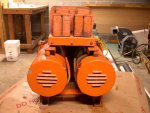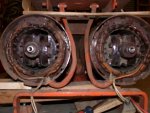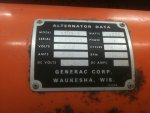- 144
- 17
- 18
- Location
- Westminster/MD
Matt, thanks. I learned a lot from this thread.
Tom
Tom
Steel Soldiers now has a few new forums, read more about it at: New Munitions Forums!

Interesting...I actually had typed out a response and then had to delete it because realized what you were actually trying to do!Great video!! Some time ago I used to work next door to a place that did referb of military units for private label. They had a bunch of units like yours and larger. I got my hands on a 2 cylinder Yanmar diesel and a couple of 5KW single phase generators, i was thinking about doing something sort of simalar, running both gens off one motor. Can i safely get 120/240 volts out of both combined or would i need to run the independent at 120 volts. I suspect only the later?? Again great video!!!!!!
I was thinking about this possibility when I posted my edit...I think it might work, but I had some kind of nagging "what if" in the back of my head.Since your genheads are single phase, if you can configure the genheads for proper voltage, might consider following proceedures in post 43, and connecting them in SERIES!! No circulating currents, no chance of overloading one head if other develops a problem.
I THINK that's what he intended to do....two 5kw single phase generators connected to one engine. I agree...two sets NOT mechanically connected would not work in this manner, not without some uber-complicated electronic throttle control on both engines.In parallel the generators are locked together. Even a small phase difference causes the two to try to match each other. In series, I would think that the tendency would be to go to 180 degrees out of phase and produce zero power. What would make them want to stay out of phase so the output added up? If it's two generators on one engine, then OK, but if it's two separate motor-gens, then I don't think it's going to work.
Don't even try it with 2 different engines. Genheads have to be identical and locked together. As I said follow Sewerzuk's post 43 to align rotor and stator on single shaft. Each VR keeps it's genhead at 120.but if it's two separate motor-gens, then I don't think it's going to work.
i think that's what he intended to do....two 5kw single phase generators connected to one engine. I agree...two sets not mechanically connected would not work in this manner, not without some uber-complicated electronic throttle control on both engines.
It would be a fun project...not something i have ever seen, but i guess i can't come up with any reason why it won't work. Its way cooler to have two 5kw generators in parallel (or series) powered by the same engine than it is to just go buy an -003a!
I've been using my lister flywheel engine and st gen head as backup power for my shop recently. Why? Because it is a really cool generator!
Pete, if you decide to attempt this, let me know. I'd be happy to give some advice!
I agree with your assessment IF both generators of 120 output each were being combined to produce a single circuit 120 at 2x power. However, to produce 240/120 from two 120 generators I believe they only need to be fairly closely phased and one lead from each tied together as a neutral. The potential between the remaining leads would be 240. A common regulator would work until there was an imbalance on the 120 sides. It would be best for the regulator to sense the 240, still questionable as to success with unbalanced loads. However, the small MEP-016B, E and 701A are 6 lead machines with voltage regulation only sensing one coil, the T1-T4 coil. These machines operate in a 240/120 mode connected in a zig zag configuration. I don't have a scope and have not seen waveforms but the voltage variation between legs does not appear to be terrible when loads are not balanced or only one sgnificant load is on one leg. I imagine there are induction effects that work to help level it to some extent.Interesting...I actually had typed out a response and then had to delete it because realized what you were actually trying to do!
Well, I would say that it is possible. The critical part of this would be making sure that the rotor and stator of each generator are EXACTLY aligned (since you can't adjust their frequencies independently, with them both connected to the same crankshaft). It would also be nice to use a single voltage regulator to control both fields...
If I was doing this, before I connected the two generators together I would run them independently and look at their waveforms with my oscilloscope to make sure they were exactly in phase. If they were off even just a little bit, you would have huge circulating currents that could damage the generator heads, cabling, or the voltage regulator.
edit: there is much more to this; including the type of generator head, the VR you plan to use, etc. There are other options for how to wire these together...almost too much to get into without actually having the generators in front of me to look at.



